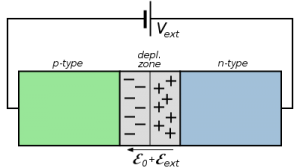There are 2 ways to collect solar energy namely: solar furnace and solar cell.
Solar furnace

Directs all photons into a single spot, causing vaporization of process fluid,the sudden increase in pressure is converted to electricity via an electric generator.
Solar cell

Solar panel is a short form name for photovoltaic cell. A voltage is created when it is exposed to photons; thus the name ‘photovoltaic’.
Photovoltaic cell is actually a huge cluster of diodes. Before we continue with PV cells, we need to know what diodes is.
Diode is a system with a N-type semiconductor and P-type semiconductor connected together.
A semiconductor is made mostly of silicon or any group 4 elements, along with some group 3 and 5 elements.
Silicon have 4 valence electrons. A thin sheet of silicon is called a ‘Silicon wafer’.
By adding a group 5 element such as phosphorus into silicon, we get N- type semiconductor. Similarly, adding a group 3 element such as boron into silicon yields a P-type semiconductor.
By placing N and P type semiconductor in contact with each other. An exchange of electrons and holes takes place. Such an arrangement is called a diode.
| N-type semiconductor | P-type semiconductor | |
|---|---|---|
| Charge | Neutral | Neutral |
| Moving charges | Electrons | Holes |
| To fulfill octet structure | Need holes | Need electrons |
We can see from the table above that N-type semiconductor need holes to obtain octet structure while p-type semiconductor needs electrons to obtain octet structure.
In the N type semiconductor, to obtain octet structure, it need holes. But when it gets sufficient amount of holes, it becomes positively charged. And it will stop accepting holes. Likewise for P type semiconductor, it needs electrons, but when it gets sufficient amount of electrons, it becomes negatively charged and will stop accepting electrons. The region where such a balance is attained is known as the “depletion region”. In this state, the whole diode has no charge and putting a voltmeter on the ends of P or N side has no voltage.

When photons hit the depletion region, the electron-hole pairs dissociated and move to their respective locations.